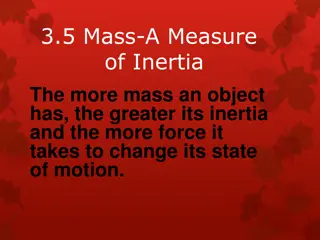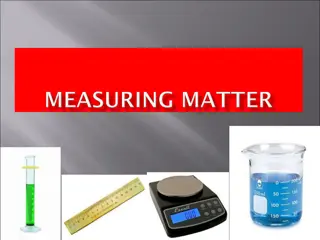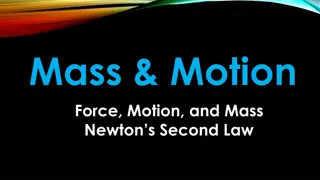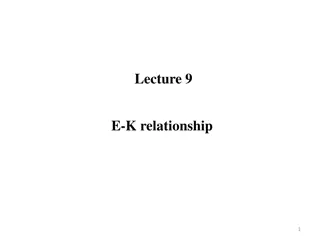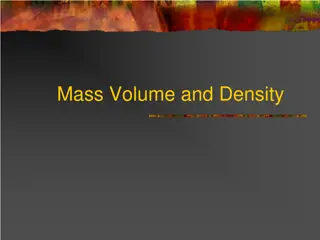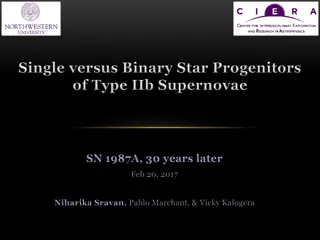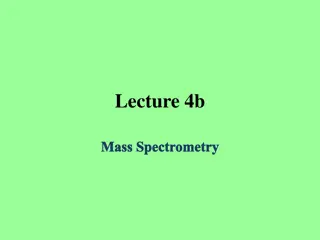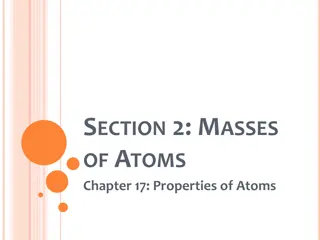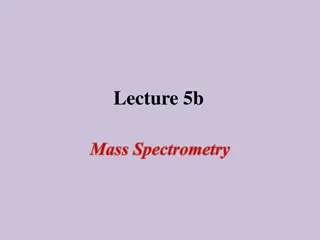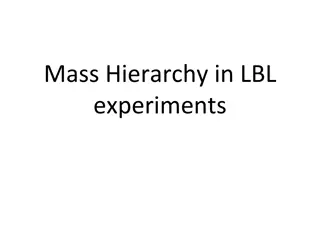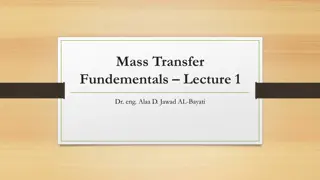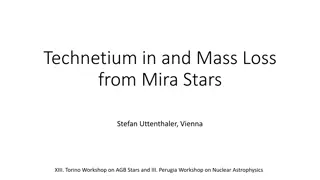
Top Mass Determination at Cavendish Laboratory: Importance and Implications
Understanding the top quark mass is crucial for precision in collider physics and determining theoretical models' accuracy. This article discusses the significance of top mass determination, its impact on the fate of the Universe, and the ongoing efforts to achieve high precision in its measurement.
Download Presentation

Please find below an Image/Link to download the presentation.
The content on the website is provided AS IS for your information and personal use only. It may not be sold, licensed, or shared on other websites without obtaining consent from the author. If you encounter any issues during the download, it is possible that the publisher has removed the file from their server.
You are allowed to download the files provided on this website for personal or commercial use, subject to the condition that they are used lawfully. All files are the property of their respective owners.
The content on the website is provided AS IS for your information and personal use only. It may not be sold, licensed, or shared on other websites without obtaining consent from the author.
E N D
Presentation Transcript
On the top mass determination Alexander Mitov Cavendish Laboratory Based mainly on: Juste, Mantry, Mitov, Penin, Skands, Varnes, Vos, Wimpenny 13
Introduction: Why do we care about the top quark mass? Precision EW tests: the place in collider physics that is most sensitive to mtop . With the discovery of the (presumably SM) Higgs boson the SM is complete and the tests are over-determined. Everything looks good. The bottleneck is the uncertainty on the W mass. Top mass will be competitive once the ultimate W mass precision (at LHC) is achieved. All other places in collider physics are even less sensitive to mtop . However: there is very strong dependence on mtop in models that rely on bottom-up approaches. These take some data at EW scale (measured) and then predict (through RG running) how the model looks at much larger scales, say O(MPlank). Two types of uncertainties appear: Chetyrkin, Zoller 12-13 Bednyakov, Pikelner, Velizhanin `13 Due to running itself Due to boundary condition at EW. It is here mtop is crucial. Examples: Bezrukov, Shaposhnikov 07- 08 De Simone, Hertzbergy, Wilczek 08 o Higgs inflation. Model very predictive; relates SM and CDM parameters. Agrees with Planck data. o Vacuum stability in SM. Change of 1 GeV in mtop shifts the stability bound for SM from 1011 to the Plank scale. Degrassi, Di Vita, Elias-Miro, Espinosa, Giudice, Isidori, Strumia 12 La Thuile, 27 Feb 20141 This is the place where high precision in mtop is needed most. Top mass determination Alexander Mitov
The fate of the Universe might depend on 1 GeV in Mtop! Higgs mass and vacuum stability in the Standard Model at NNLO. Degrassi, Di Vita, Elias-Miro, Espinosa, Giudice, Isidori, Strumia 12 Vacuum stability condition: Quantum corrections (included) 2 Possible implication: For the right values of the SM parameters (and we are right there) SM might survive the Desert. Currently a big push for better understanding of the top mass. Precision is crucial here Top mass determination Alexander Mitov La Thuile, 27 Feb 2014
Introduction: goals regarding top mass determination at hadron colliders The apparent sensitivity to mtop requires convincing mtop determination What do I mean by convincing? mtop is not an observable; cannot be measured directly. It is extracted indirectly, through the sensitivity of observables to mtop The implication: the determined value of mtop is as sensitive to theoretical modeling as it is to the measurement itself The measured mass is close to the pole mass (top decays ) One needs to go beyond the usual MC s to achieve theoretical control 3 Lots of activity (past and ongoing). A big up-to-date review: Juste, Mantry, Mitov, Penin, Skands, Varnes, Vos, Wimpenny 13 Top mass determination Alexander Mitov La Thuile, 27 Feb 2014
Introduction: goals regarding top mass determination at hadron colliders A worry: can there be an additional systematic O(1 GeV) shift in mtop ? Two types of possible hidden errors: QCD related. As follows from the equation: the precision in mtop determination reflects the experimental uncertainty, as well as the error on the theory input. Unaccounted theory sources might have impact. Typical situation: using a MC to construct a likelihood and find the likeliest value of mtop. Combine with other methods/measurements to improve errors, etc. etc. At each step the error seemingly decreases. But this is not so, because we have irreducible error that the MC generator simply may not know about and no improvement in the measurement will take care of it. Such errors are the scariest since they are hidden (bias). bSM related. Unexplored territory. Conceptually the same as above, but the the role of higher order terms is now played by bSM physics: it contributes to the measurement but is not accounted for on the theory side. Basically, a kind of bias again. La Thuile, 27 Feb 20144 Top mass determination Alexander Mitov
Issues in top mass determination La Thuile, 27 Feb 20145 Top mass determination Alexander Mitov
Introduction: issues in top mass determination MC modeling. Most methods for extraction of mtop rely on modeling the measured final state with typically LO+LL MC generators. The extracted mass then reflects the mass parameter in the corresponding MC generator. Identifying the nature of this mass parameter and relating it to common mass schemes, like the pole mass, is a non-trivial and open problem. It may be associated with ambiguities of order 1 GeV. Buckley, Butterworth, Gieseke et al Phys. Rep. 11 The effect of the top and bottom masses on parton-shower radiation patterns is generally included already in the LO+LL MC s and they screen collinear singularities. Non-perturbative corrections: Mostly affect the MC modeling of the final state. Includes hadronization, color reconnection, Underlying Event, final state interactions (especially with jet vetoes). La Thuile, 27 Feb 20146 Many such systematics are accounted for through the JES. Color reconnection small at e+e- but O(500 MeV) at hadron colliders. Recommendation: try methods with alternative systematics (unrelated to MC). Top mass determination Alexander Mitov
Introduction: issues in top mass determination Reconstruction of the top pair. Typically, the existing methods for extraction of the top quark mass implicitly or explicitly rely on the reconstruction of the top pair from final state leptons and jets. This introduces uncertainties of both perturbative origin (through higher-order corrections) and non-perturbative origin (related to showering and non-factorizable corrections). Methods that do not rely on such reconstruction are therefore complementary and highly desirable; two examples are J/ methods and dilepton distributions. This is correlated with the attempt to define a pseudo top. How needed/useful is that? La Thuile, 27 Feb 20147 Top mass determination Alexander Mitov
Introduction: issues in top mass determination Alternative top mass definitions. Alternative mass definitions that reflect the physics are beneficial (known from e+e-). Less clear at hadron colliders. Renormalon ambiguity in top mass definition. Pole mass of the top quark suffers from the so-called renormalon ambiguity. This implies an additional irreducible uncertainty of several hundred MeV's on the top pole mass. Not an issue for short distance masses. Currently, at hadron colliders, this is a subdominant uncertainty. Higher-order corrections. La Thuile, 27 Feb 20148 Important source of uncertainty. State of the art NLO QCD; not always included. Top mass determination Alexander Mitov
Introduction: issues in top mass determination Unstable top and finite top width effects. Understood for e+e-. Computed at NLO for hadron colliders. Could affect certain distributions. Melnikov, Schulze Not really used so far in top mass studies. Bound-state effects in top pair production at hadron colliders. When the ttbar pair is produced with small relative velocity (i.e. close to threshold) bound-state formation begins. These effects can affect the shape of differential distributions within few GeV away from the threshold. Special care must be taken if a measurement is sensitive to such effects. La Thuile, 27 Feb 20149 In usual inclusive observables (like total x-section) this effect is diluted to about 1%. Top mass determination Alexander Mitov
Methods for mtop determination La Thuile, 27 Feb 2014 10 Top mass determination Alexander Mitov
Methods for mtop determination: Matrix Element Methods The backbone of the Tevatron studies as well as the most precise LHC ones. Performed in all final states. Measured objects are compared with expectations from the LO tt production and decay diagrams convoluted with the detector response. Method s power comes from the fact that the likelihood for each event to be consistent with both tt and background production is calculated; greater weight is assigned to events that are more likely to be from tt when measuring mtop. Issue: incorrect modeling due to missing theory corrections. La Thuile, 27 Feb 2014 11 Top mass determination Alexander Mitov
Methods for mtop determination: Matrix Element Methods Projections based on CMS lepton-plus-jet analysis: Projections beyond 14 TeV require full detector simulation. Not done here. Pileup and UE become more important at higher energy/pileup. La Thuile, 27 Feb 2014 12 ISR/FSR become dominant uncertainties at high luminosity (unlike current measurements) Extra 300MeV uncertainty added by hand. Top mass determination Alexander Mitov
Methods for mtop determination: CMS endpoint method A kinematical method: utilizes the strong correlation between the maximum of the Mbl distribution and mtop. ISR/FSR and pileup do not play a role at high luminosity. (unlike conventional methods) Does not rely on MC for internal calibration (analytical with data-driven backgrounds). Less likely to be affected by bSM corrections. La Thuile, 27 Feb 2014 13 Nonetheless, higher order effects do affect the endpoint position (particularly top widths) NLO calculations do exist not utilized. Top mass determination Alexander Mitov
Methods for mtop determination: J/ method A different method: no reconstruction is involved. Known at NLO. Estimates from NLO QCD. (see also) NNLO accuracy assumed in some extrapolations. La Thuile, 27 Feb 2014 14 Main source: B-fragmentation. Likely will be irreducible unless new e+e- data. Top mass determination Alexander Mitov
Methods for mtop determination: mtop from kinematic distributions Total cross-section: Allows extraction with about 3% uncertainty due to limited sensitivity to mtop . Positive features: Good theory control (NNLO) Small non-perturbative and width effects Latest Tevatron Combination: 1309.7570 Negatives: La Thuile, 27 Feb 2014 15 Small sensitivity (unlikely to improve) At present there are inconsistently applied acceptance corrections (i.e. LO or NLO not NNLO). Still, likely a small effect. Top mass determination Alexander Mitov
Methods for mtop determination: mtop from kinematic distributions Extraction suggested from tt+jet. Estimates for contributions from unknown corrections below 1 GeV. Method is MC dependent and involves t (tbar) reconstruction Dilepton distributions No reconstruction Minimal shower and NP sensitivity. Reliably computable at fixed order. Potential for 14 TeV at 1.5 GeV. La Thuile, 27 Feb 2014 16 Further studies in progress Frederix, Frixione, Mitov, in progress. Top mass determination Alexander Mitov
Top mass from leptonic distributions An example of an orthogonal approach (in NLO QCD) Frederix, Frixione, Mitov, in progress. Measured Parameter (1st moment) Predicted top mass 17 From this distribution, with zero exp error, we can extract mtop with error of 0.85 GeV One day, at NNLO, this can be improved. 8 TeV seems better than 14 TeV. Top mass determination Alexander Mitov La Thuile, 27 Feb 2014
e+e- colliders The machine where the ultimate precision of 100MeV or less can be achieved. Best approach is threshold scan. Continuum production also possible. Similar at ILC and CLIC. Interesting question: is it possible to measure mtop at c.m. energy of, say, 250GeV, i.e. below the threshold? Given the presumed ILC schedule this might imply few more years of waiting La Thuile, 27 Feb 2014 18 Top mass determination Alexander Mitov
New Physics contributions to mtop One hardly mentioned problem! There is the possibility that undetected corrections to top production might shift the top mass measurements (measure top+bSM but theory assumes pure SM). Example: stop -> top+X If the stop is light, the event looks top-like! The strongest constraint on bSM contributions to mtop comes from the CMS end-point method The method is kinematic: it measures the position of the end-point of the spectrum of top decay products. This is independent of the top production mechanism. The total error from the measurement is just above 2.0 GeV and agrees with the world average. From here we can conclude that bSM contributions to mtop are not larger than ~2GeV. La Thuile, 27 Feb 2014 19 Dedicated studies are welcome. Likely they will be model dependent; any model-independent arguments would be very valuable. Top mass determination Alexander Mitov
Conclusions New developments have resurrected the interest in knowing mtop precisely Vacuum Stability in SM Higgs Inflation There are many dedicated hadron collider measurements. They return consistent values around mtop = 173 GeV and uncertainty (mostly on the measurement!) of around 1 GeV. Questions remain: can there be a significant additional theoretical systematics O(1 GeV) ? This is not an abstract problem: mtop is not an observable and so is a theoretically defined concept. The issue of various mass definitions is a non-issue at present for hadron colliders. e+e- colliders offer the real possibility of measuring mtop with x10 precision, i.e. O(100 MeV) But how long would we have to wait for a ttbar threshold scan? La Thuile, 27 Feb 2014 20 New physics contributions to mtop are a totally open question. Upper limit of O(2 GeV) likely can be placed at present. Top mass determination Alexander Mitov
Methods for mtop determination: ATLAS 3-dimensional template fit method Similar method in lepton-plus-jets final state. Extracts mtop together with 2 other parameters: La Thuile, 27 Feb 2014 21 Top mass determination Alexander Mitov



